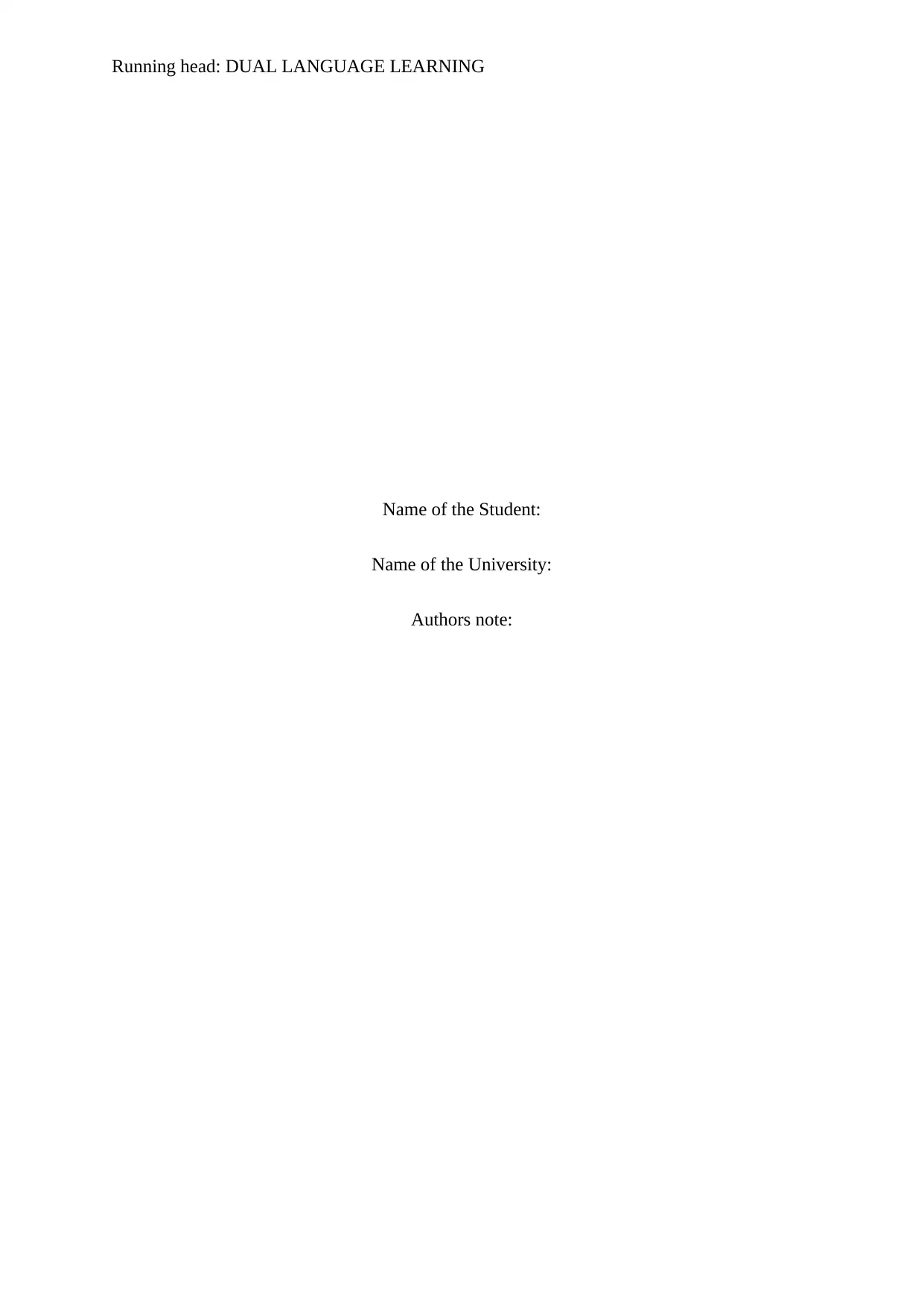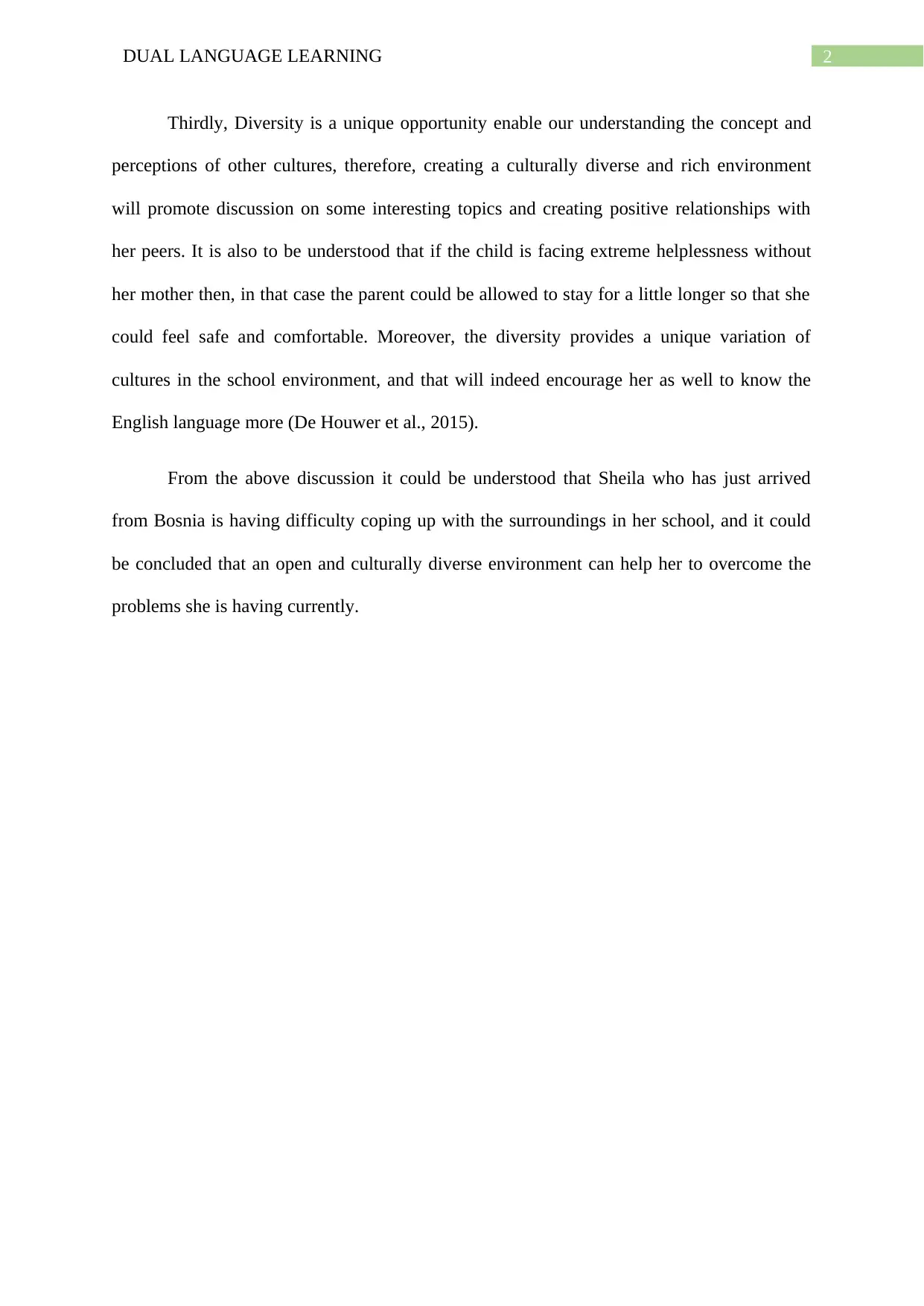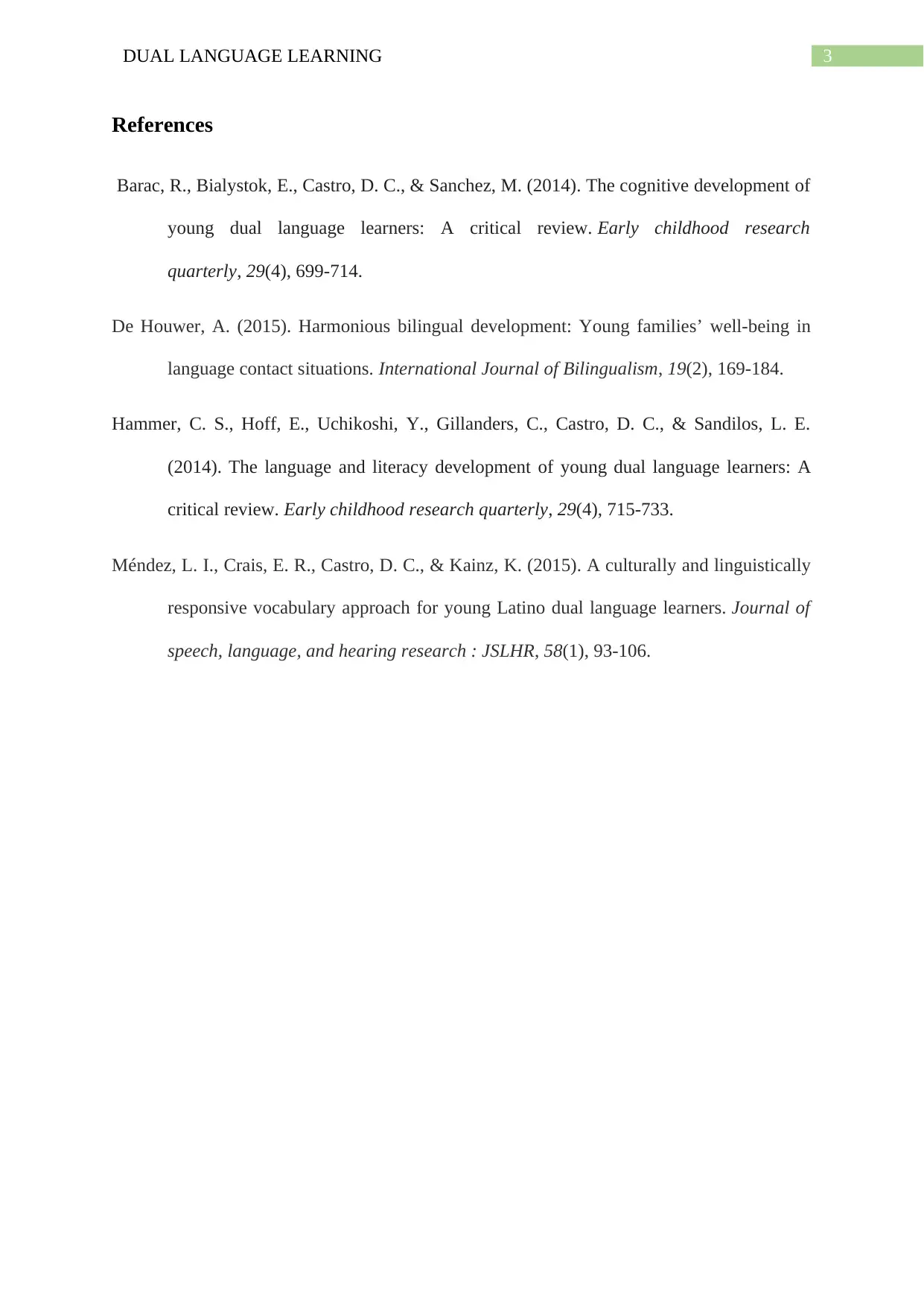Analysis of Dual Language Learning in Early Childhood Education
VerifiedAdded on 2023/04/25
|4
|798
|91
Report
AI Summary
This report analyzes a case study of a four-year-old child named Sheila, who is a dual language learner from Bosnia, newly enrolled in school. The report examines her initial challenges, including unfamiliarity with the school environment, longing for her mother, and a different linguistic and cultura...

Running head: DUAL LANGUAGE LEARNING
Name of the Student:
Name of the University:
Authors note:
Name of the Student:
Name of the University:
Authors note:
Paraphrase This Document
Need a fresh take? Get an instant paraphrase of this document with our AI Paraphraser

1DUAL LANGUAGE LEARNING
In this scenario Sheila is only four year old child, and she comes from different
cultural back ground as well as a different country. Firstly, the child may be new to the
schooling environment all together, and it is mentioned that the child awaits for her mother
and does not participate in any activities. Secondly, this child comes from a different
linguistic culture which is different to the cultural and linguistic habit in the place she has
recently arrived. Therefore, in this case dual language or in her bilingualism can be a very
common experience for children of that age (Barac, 2014).
From the case study it could be understood that the all the inactiveness and longing
for the mother is a common behaviour especially for a girl child of this age. Therefore, there
should be no referred evaluation for the child, as the behaviour perfectly normal. To
encourage her to participate in school activities, there can be strategies that could be applied
for the child to overcome the problems she is facing. Firstly the child is experiencing an
unknown social environment therefore, there should be firstly given a very warm and positive
environment so that she could feel the welcoming attitude of the teachers and her peers. The
moment she is exposed to the positive environment there is a great tendency that the child
will gradually open up and communicate freely with the people around her (Méndez et al.,
2015).
Second strategy is that Sheila’s interest and unique communication patterns should be
recognized and noticed so that the educator or the teacher could involve her in specific
activities. For example she might like painting or doing crafts or may be singing her culture’s
or region’s songs. By doing and encouraging her this the teacher would not only be able to
involve her in the daily activities, she will safe and comfortable in the school environment. It
is to be understood that she will have the advantage of knowing two language and moreover
Sheila is in her early development face, if she gets the right environment she will definitely
get an academic advantage in future (Hammer et al., 2014).
In this scenario Sheila is only four year old child, and she comes from different
cultural back ground as well as a different country. Firstly, the child may be new to the
schooling environment all together, and it is mentioned that the child awaits for her mother
and does not participate in any activities. Secondly, this child comes from a different
linguistic culture which is different to the cultural and linguistic habit in the place she has
recently arrived. Therefore, in this case dual language or in her bilingualism can be a very
common experience for children of that age (Barac, 2014).
From the case study it could be understood that the all the inactiveness and longing
for the mother is a common behaviour especially for a girl child of this age. Therefore, there
should be no referred evaluation for the child, as the behaviour perfectly normal. To
encourage her to participate in school activities, there can be strategies that could be applied
for the child to overcome the problems she is facing. Firstly the child is experiencing an
unknown social environment therefore, there should be firstly given a very warm and positive
environment so that she could feel the welcoming attitude of the teachers and her peers. The
moment she is exposed to the positive environment there is a great tendency that the child
will gradually open up and communicate freely with the people around her (Méndez et al.,
2015).
Second strategy is that Sheila’s interest and unique communication patterns should be
recognized and noticed so that the educator or the teacher could involve her in specific
activities. For example she might like painting or doing crafts or may be singing her culture’s
or region’s songs. By doing and encouraging her this the teacher would not only be able to
involve her in the daily activities, she will safe and comfortable in the school environment. It
is to be understood that she will have the advantage of knowing two language and moreover
Sheila is in her early development face, if she gets the right environment she will definitely
get an academic advantage in future (Hammer et al., 2014).

2DUAL LANGUAGE LEARNING
Thirdly, Diversity is a unique opportunity enable our understanding the concept and
perceptions of other cultures, therefore, creating a culturally diverse and rich environment
will promote discussion on some interesting topics and creating positive relationships with
her peers. It is also to be understood that if the child is facing extreme helplessness without
her mother then, in that case the parent could be allowed to stay for a little longer so that she
could feel safe and comfortable. Moreover, the diversity provides a unique variation of
cultures in the school environment, and that will indeed encourage her as well to know the
English language more (De Houwer et al., 2015).
From the above discussion it could be understood that Sheila who has just arrived
from Bosnia is having difficulty coping up with the surroundings in her school, and it could
be concluded that an open and culturally diverse environment can help her to overcome the
problems she is having currently.
Thirdly, Diversity is a unique opportunity enable our understanding the concept and
perceptions of other cultures, therefore, creating a culturally diverse and rich environment
will promote discussion on some interesting topics and creating positive relationships with
her peers. It is also to be understood that if the child is facing extreme helplessness without
her mother then, in that case the parent could be allowed to stay for a little longer so that she
could feel safe and comfortable. Moreover, the diversity provides a unique variation of
cultures in the school environment, and that will indeed encourage her as well to know the
English language more (De Houwer et al., 2015).
From the above discussion it could be understood that Sheila who has just arrived
from Bosnia is having difficulty coping up with the surroundings in her school, and it could
be concluded that an open and culturally diverse environment can help her to overcome the
problems she is having currently.
⊘ This is a preview!⊘
Do you want full access?
Subscribe today to unlock all pages.

Trusted by 1+ million students worldwide

3DUAL LANGUAGE LEARNING
References
Barac, R., Bialystok, E., Castro, D. C., & Sanchez, M. (2014). The cognitive development of
young dual language learners: A critical review. Early childhood research
quarterly, 29(4), 699-714.
De Houwer, A. (2015). Harmonious bilingual development: Young families’ well-being in
language contact situations. International Journal of Bilingualism, 19(2), 169-184.
Hammer, C. S., Hoff, E., Uchikoshi, Y., Gillanders, C., Castro, D. C., & Sandilos, L. E.
(2014). The language and literacy development of young dual language learners: A
critical review. Early childhood research quarterly, 29(4), 715-733.
Méndez, L. I., Crais, E. R., Castro, D. C., & Kainz, K. (2015). A culturally and linguistically
responsive vocabulary approach for young Latino dual language learners. Journal of
speech, language, and hearing research : JSLHR, 58(1), 93-106.
References
Barac, R., Bialystok, E., Castro, D. C., & Sanchez, M. (2014). The cognitive development of
young dual language learners: A critical review. Early childhood research
quarterly, 29(4), 699-714.
De Houwer, A. (2015). Harmonious bilingual development: Young families’ well-being in
language contact situations. International Journal of Bilingualism, 19(2), 169-184.
Hammer, C. S., Hoff, E., Uchikoshi, Y., Gillanders, C., Castro, D. C., & Sandilos, L. E.
(2014). The language and literacy development of young dual language learners: A
critical review. Early childhood research quarterly, 29(4), 715-733.
Méndez, L. I., Crais, E. R., Castro, D. C., & Kainz, K. (2015). A culturally and linguistically
responsive vocabulary approach for young Latino dual language learners. Journal of
speech, language, and hearing research : JSLHR, 58(1), 93-106.
1 out of 4
Related Documents
Your All-in-One AI-Powered Toolkit for Academic Success.
+13062052269
info@desklib.com
Available 24*7 on WhatsApp / Email
![[object Object]](/_next/static/media/star-bottom.7253800d.svg)
Unlock your academic potential
© 2024 | Zucol Services PVT LTD | All rights reserved.





